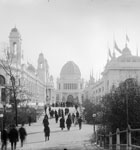Looking at images of the 1893 World’s Columbian Exhibition, set on the shore of Lake Michigan, south of downtown Chicago, I still feel a sense of wonder. The White City was a beaux arts fantasy that looked as if Zeus himself had thrust it down upon Earth from the heavens above. Architectural impresario
Daniel Burnham, along with America’s first generation of “starchitects,” transformed a derelict 1,100 acres of swampland into a dreamy city of white neoclassical pavilions. The design ushered in a new image of what a city could, and should be.
Called the City Beautiful movement, Burnham’s philosophy proposed that urban design creates social order and civic virtue if executed correctly. Chicago, San Francisco, and Washington, DC, bare the imprint of this movement. But I wonder what our generation’s City Beautiful looks like. Though the virtues of the original City Beautiful movement are worthy goals, the sustainable design movement and all its offshoots demand that we look in a radically new way at what makes a city beautiful.
Genuinely sustainable design, by its nature, is beautiful. It is embedded in a rich understanding of the Earth and its processes. It appreciates the complex connections between people and the environment. It accepts that our Earth is the source and sink of all that we produce. In sustainable design, everything matters because everything is interconnected. Look at urban design this way and the White City turns to Technicolor.
Sustainable city planners like to judge the worth of their projects against a set of criteria known as the three E’s: environment, equity, and economy. Burnham’s White City wouldn’t have fared well using these criteria: tons of concrete was poured into a fragile ecosystem, workers were denied the right to unionize, and nearly all the structures were abandoned after one summer season. Yet I wonder if glamorous “green” cities such as Tianjin Eco-City in China would fare much better? Can such cities really be considered sustainable?
Some cities, it seems, got lucky. They have built-in attributes that make them more easily able to adapt to sustainability. Reykjavik, Iceland, a city of a mere 170,000 inhabitants, is situated on the Mid-Atlantic Ridge, which produces geothermal forces that can power and heat the city in a clean and efficient way. Since the 1930s Reykjavik has built upon this regional asset and blossomed, creating a city and society that are on the forefront of sustainable design in every way. But then again, it only has 170,000 inhabitants. Our planet’s population is expected to grow to 9.4 billion by the year 2050.
I think cities such as Portland, Oregon, offer us a better glimpse of how the new City Beautiful will come about. Portland and its surrounding area are home to more than 2.5 million people. Through sometimes strongly conflicting interests, the city has created a culture in which citizenry embrace the green movement. There is a broad understanding of the interconnections at play in sustainable design. Where else might you find a brochure for an upcoming neighborhood meeting that promises to explore “topics like district energy and water utilities, net zero buildings, smart grid, networked transportation, urban ecosystem services, zero waste and human behavior”?
Working through the three E’s ignores a central aspect of sustainability, though. Frederick Steiner, dean of the School of Architecture at the University of Texas, says that one final consideration is essential: aesthetics. “Often green concerns have been advanced at the expense of aesthetics,” he says. “Many early green buildings produced by green architects appear like post-hippie structures, habitable granola bars, which may be good for us but leave us wanting. … A compelling environmental aesthetic remains just beyond our reach.” We turn to nature to understand the complex ecologies involved in urban design, and we should also turn to it for our aesthetic design inspiration. “Study nature, love nature, stay close to nature—it will never fail you,” Frank Lloyd Wright once said. Indeed, something as simple and perfect as an egg can lead us to beautiful design.
I don’t think the ideal new City Beautiful has been realized. Maybe a reader of this column will help get us closer to it. I also don’t think it will look as if it came down from the clouds in the hands of Zeus, either. Maybe it will look like it sprung up from the Earth, like it’s always been there, a part of nature itself.
Alan Oakes is an architectural historian, writer, and documentarian. He can be reached at oakesaland@gmail.com.

